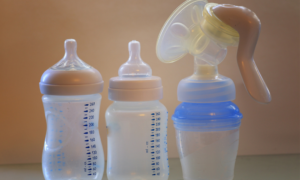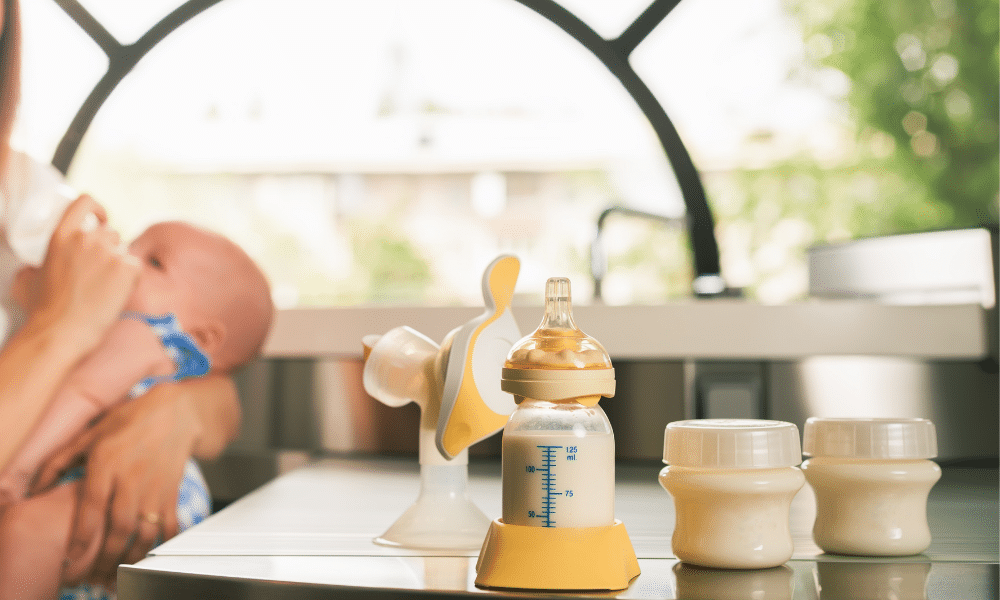Breastfeeding Questions And Answers All You Need To Know
We have created this article as an information source for all Mothers who breastfeed their child and for expecting Mums and Dads who, of course, will have a vast array of questions on the experience of breastfeeding. Please look through the following topics, which contain answers to many of the most frequently asked questions about breast feeding.
Being informed on every aspect of breastfeeding will help you get off to a good start with your baby while providing them with the best nutrition available.
We encourage you to read as many possible breastfeeding topics, which contain the latest breastfeeding information and recognize and solve the most common breastfeeding difficulties. Good luck with your experience of breastfeeding. To look down and see that contented, blissfully happy baby nursing at your breast can be one of the most satisfying enjoyments in your life! Enjoy!
Breastfeeding – Advantages for Mother and Baby
Bringing a baby into the world is an incredible and profound experience in your life and the beginning of a lifelong relationship of loving and caring for your very own child.
Feeding your newborn baby is one of your primary contributions to his average growth and well being.
Nature has provided you with the most advanced, easiest, and economical way of feeding your baby: BREASTFEEDING.
When you breastfeed, you are providing your baby with the best possible infant food.
But breastfeeding provides more than the best nutrition. It is more than the most convenient and economical method: It is an act of love. Through this special bond with the mother, the baby learns to receive love and grow to be a person who can love in return.
Breastfeeding has many advantages for the mother and baby!
Advantages for Baby
- Breastfed babies are proven healthier; breastmilk contains antibodies, which help protect your baby from colds, chest- and ear infections, stomach upsets, and diarrhea.
- Breastmilk is easily digested, and breastfed babies are very rarely constipated.
- Breastfed babies have fewer allergies.
- Breastmilk contains Taurine, an amino acid, which contributes to optimal brain growth.
- Breastmilk is continuously changing in its composition as the baby grows to meet its changing needs. It contains all the right ingredients your baby needs to grow well and to develop. It is the only food needed for your baby until he is about six months old.
- Breastfed babies are at lower risk for juvenile diabetes and Crohn’s disease.
Advantages for Mother
- Nursing soon after delivery helps to contract the uterus and lowers the risk of postpartum hemorrhage.
- Breastfeeding enables you to lose that extra weight you gained during pregnancy.
- Breastfeeding for at least six months helps protect against pre-menopausal breast cancer.
- Breastfeeding helps protect against cervical cancer and osteoporosis.
- Breastmilk is always available, needs no preparation, is still at the right temperature, and requires no refrigeration or sterilization.
- Night feedings are more comfortable, with no bottles to heat up.
- Many physical contacts bring mother and baby emotionally closer and help develop a strong bond between them.
How The Breast Works
Breasts come in many shapes and sizes. This does not affect milk production. A woman with small breasts can produce the same amount of milk as a woman with larger breasts.
The dark area around the nipple is called the areola. On the areola, you find the Montgomery glands. They look like small pimples.
They produce an oil that lubricates the nipple and discourages the growth of bacteria. At the end of the nipple, you will find the nipple pores where your baby receives the milk.
Milk is produced in the alveoli, grape like clusters of glandular tissue deep within the breast.
The milk is expelled in small milk ducts from the alveoli, and they empty into larger ducts.
These larger ducts widen underneath the nipple and areola and form reservoirs where milk collects.
The milk collected in these reservoirs or sinuses is the baby’s milk first when he starts to nurse. It is called “fore milk.” It is thirst-quenching, high in volume, low in fat.
While your baby nurses, new milk is being produced in the alveoli.
This milk contains more proteins, fat, and calories than the foremilk, and this is the milk that puts weight on your baby. It is called “hind milk.”
The baby’s sucking causes a hormone called oxytocin to squeeze this milk down the ducts to the nipple.
This is the “letdown reflex,” and you might feel a tingly feeling in your breast.
This usually happens a minute or so after your baby starts nursing.
Prenatal Nipple Care
At one time, it was recommended to prepare your nipples during pregnancy to avoid sore nipples during breastfeeding (rubbing them with a towel or squeezing out colostrum).This has not been proven helpful.
It is now recognized that poor positioning and latch-on of the baby cause nipple soreness in the early stages of breastfeeding, and careful attention needs to be paid to these aspects.
Nipple preparation is no longer recommended. It is best to avoid using soap, alcohol, or antiseptics on your nipples since they can dry the skin. Rinsing with plain water when you take your shower is enough.
If your skin feels dry, you can put some modified lanolin or other cream recommended by your GP or midwife.
It is advisable to check for flat or inverted nipples during the last months of pregnancy.
This can be done as follows: place a thumb and forefinger near the base of the nipple and press gently together. If your nipple does not come out far enough for you to grasp it, you may have flat or inverted nipples, and you may want to start wearing breast shells during the last months of your pregnancy.
The positioning of your baby on the breast
Proper positioning and latch on the baby are essential, especially in the initial weeks of breastfeeding when you and your baby are still becoming used to this. It can prevent you from getting sore nipples and other breastfeeding problems.
When your baby is positioned well and has latched on properly, breastfeeding should not hurt.
If you do feel pain or you see that your baby is not latched on well, take the baby from the breast by inserting your finger in the side of baby’s mouth to break the suction and start again.
Never pull a baby from the breast while they are sucking. It hurts and can damage your nipples.
Follow the directions carefully below to position your baby correctly.
HOW TO POSITION YOUR BABY STEP BY STEP GUIDE
STEP A: POSITION YOURSELF
It is easier to breastfeed sitting up, in bed, or in a comfortable chair in the first days after birth.
Use a pillow behind your back, under the arm that’s holding the baby, on your lap to support the baby, and under your knees if you are sitting up in bed.
If you sit in a chair, put your feet up on a nursing stool or small table.
You will spend lots of time feeding the baby so make sure you are comfortable.
STEP B: POSITION YOUR BABY
- The baby should be lying on his side with his whole body facing you.
- With head should rest in the crook of your arm.
- Your forearm supports their back, and you can hold the bottom with your hand.
- The baby’s ear, shoulder, and hips should be in a straight line.
- The head should be straight in line with his body.
Baby should be at the level of your breast, so you do not have to lean forward. It is therefore handy to have the baby lying on a pillow on your lap or use a nursing pillow to provide back, arm and elbow support and to prevent strain on your muscles.
STEP C: PUTTING THE BABY TO THE BREAST
- Support your breast with your hand, fingers underneath, and your thumb on top of your breast.
- Be sure your fingers are well behind the areola.
- Tickle baby’s lips with your nipple and wait till baby opens his mouth wide.
- Center your nipple in his mouth and pull baby towards you, very close, tummy to tummy.
- Make sure your baby also has a large part of the areola in his mouth.
- The baby should be pulled in so close that his chin and nose touch the breast. Both baby’s lips must be flanged out. Some babies suck in their lower lip; this can cause nipple soreness.
- Once the baby is sucking correctly, you will see his jawline’s strong action and wiggle at the temple or ear, and you can see and hear them swallowing.
- After the baby has been sucking for a minute or so, you may feel a tingling feeling in your breast.
- This is the milk squeezed down the ducts to your nipple, and it is called the “letdown reflex.”
- You may also notice milk dripping from the other breast, have a towel handy for this.
- This leaking happens mainly in the first weeks.
- Try to be as relaxed as possible when you are breastfeeding. This will encourage your letdown. Drop your shoulders and take a few deep breaths. Enjoy the sight of your little one nursing at your breast.
SOME OTHER BREASTFEEDING POSITIONS
It is advisable to familiarize yourself with different nursing positions. In the case of sore nipples, it helps change positions to avoid constant pressure on the sore spot, and in the case of plugged ducts changing positions will assure that all the milk ducts are appropriately emptied.
Lying down to nurse
- Lay on either side with pillows supporting your head and back. A pillow between your knees is also comfortable, as is a pillow under your abdomen. See what works best for you.
- Put baby on his side, facing you, and support his head in the crook of your arm, or baby can rest his head on the bed, and you can put your arm under your head if you want.
- In this case, you can put a small pillow or rolled up towel behind his back to prevent them from rolling back. The baby’s mouth should be in line with your nipple.
- Then offer baby the breast as described above.
Lying down to a nurse is especially comfortable when sitting up is painful; for example, if you have an episiotomy or after a cesarean section.
FOOTBALL HOLD OR “CLUTCH” HOLD
- Make yourself comfortable in a chair or on the bed.
- Put also a pillow on your lap and one at your side or, even better, use a nursing pillow.
- Your baby’s body should be tucked within your arm. Their bottom rests on the pillow next to you.
- Your hand supports his head and neck.
- In this position, you can see well if the baby is latched on well.
It is also a comfortable position if you have had a cesarean section and you want to avoid pressure on your abdomen.
You may want to try other nursing positions, see what is most comfortable for you and your baby. Whatever position you choose, always ensure that your baby is positioned and latched on correctly to avoid sore nipples and other breastfeeding problems.
How long should I breastfeed my baby, and how often?
It is best to begin breastfeeding as soon as possible after birth. During the first hour or so after birth, most babies are quite awake and alert and willing to nurse. Try to arrange with your doctor or hospital staff that your baby can stay with you after birth and that they do not take them away immediately to weigh and wash them. These things can be done later. These first moments after birth are extraordinary and essential for you and your baby, and you should be given the time to get to know each other, to touch and smell, to cuddle, and to breastfeed.
When you breastfeed your baby soon after birth, your baby’s sucking will contract your uterus, which helps to expel your placenta and lessens the risk of postpartum hemorrhage. Breastfeeding soon and frequently from the beginning can help prevent painful engorgement, and your milk will come in sooner.
The milk produced in the first days after birth is called colostrum. It is a thick, yellowish substance high in protein, low in fat, and many antibodies. It is the ideal nutrition for your child. It is easily digested and works in a gentle laxative way, so your baby will pass his first stool, called meconium, faster. This helps in preventing your baby from getting jaundice.
Breastmilk is digested more comfortably and more rapidly than formula.
Furthermore, a strain isn’t put on your baby’s digestive system. The proteins in formula milk take longer and are more difficult to digest. That is the reason that formula-fed babies demand to feed less often. Therefore, a newborn breastfed baby needs to be provided at least every 2 to 3 hours during the day and 1 or 2 times during the night (8-12 times per 24 hours).
It is better not to feed your baby on a nursing schedule or limit the baby nurses’ time on the breast.
Breastfeeding is a natural process; your breasts produce milk to answer your baby feeding at your breast.
The more the baby nurses, the more milk you will produce, and vice versa.
When you nurse your baby on a schedule, your breasts may not receive enough stimulation to make sufficient milk for your baby, and this can result in inadequate weight gain and failure to thrive.
Therefore it is better to let the baby decide when and how long they want to nurse.
Some newborn babies sleep a lot in the early weeks, and it is necessary to wake them up for feeding.
Do not let your baby continuously sleep more than 4 hours during the day without nursing. They need to be fed at least once (see section NIGHT FEEDINGS for more information).
Sometimes your baby may suddenly want to nurse more often for a few days.
What is happening?
Your baby grows rapidly and needs more milk for his growing body.
When you let them nurse more often, your body will produce more milk, and your baby will go back to nursing as he did before.
These “growth spurts” can happen around 2 weeks, 6 weeks, and 3 months of age.
HOW LONG?
If your baby is positioned well, breastfeeding should not hurt, and you can feed as long as your baby wants. Let them nurse on one side until they swallow less often or dozes off. After 10-15 minutes or so, this may be put on the other side and let the baby nurse for as long as they want. The next feeding, you start on the side you last finished with.
It is best to give both breasts at each feeding, especially in the early weeks of breastfeeding, to stimulate your milk supply.
During pregnancy, you do not need to do anything special to clean your nipples. Just washing with plain water when you take your shower is enough.
Do not use soap, alcohol, or antiseptic creams on your nipples. They can dry your skin and promote soreness and cracking of the nipples. It is essential to let your nipples dry after each feeding. Leave your bra flaps open after each nursing for a few minutes until your nipples have dried.
Is my baby getting enough?
Many breastfeeding mothers worry if their baby gets enough to drink. When you are breastfeeding, you can not see how much milk the baby is getting at each feeding, in contrast with bottle feeding, when you know exactly how much he is getting. However, there are several ways of knowing if your baby is getting enough milk. Keeping track of what is coming out is one way of knowing if your baby is getting enough.
URINE OUTPUT
During the first few days, one or two wet diapers a day is typical.
Once your milk becomes more plentiful (usually your milk “comes in” the third or fourth day), the baby’s wet diapers should increase until they have at least 5 or 6 wet diapers a day.
The urine should always be pale in color, never orange or brown.
STOOL OUTPUT
The stool pattern of the breastfed baby can be used as an indicator of milk intake.
In the first days after birth, the baby will pass a black, tarry stool called meconium in his intestines before birth.
After your milk has “come in,” your baby’s stool gradually lightens in color and becomes less sticky and more liquid.
The stool of the breastfed baby is loose and unformed. At times it may contain small curds, and the color is a greenish yellow to mustard yellow. The odor is mild, “yeasty.”
Most babies stool at least 2-5 times a day.
After the first month to six weeks of life, the stooling frequency gradually declines while the volume increases. Your baby may go several days, 7-10 days is not abnormal, without stooling, the long periods between stools in the second and later months after birth are not a concern, provided that the baby’s abdomen is soft, the stool is loose, and baby is content and alert.
WEIGHT GAIN
Many babies lose some weight during the first few days. A weight loss of 5-7% is considered normal. The baby should regain his birth weight by 2-3 weeks of age.
One reason for this weight loss is that babies are born with excess fluids, which they lose in the early days.
Once your milk becomes more plentiful after the third or fourth day, your baby should begin gaining weight.
During the first 3-4 months, the average weight gain is 4-8 ounces (113-227 grams) per week. From 4-6 months of age, the average gain is 3-5 ounces (85-142 grams) a week, and from 6-12 months of age average weight gain is 1.5-3 ounces (42-85 grams) per week.
Generally speaking, babies double their birth weight by about five months, triple it by one year of age, and quadruple it by two years.
OTHER INDICATORS OF GROWTH
Increases in length and head circumference are also necessary measures of growth.
Growth in length should be about 1 inch (2.5 cm) per month and growth in head circumference ½ inch (1.27 cm) per month during the first six months, and about half that during the second 6 months.
OTHER SIGNS OF SUFFICIENT HYDRATION
Your baby’s skin should be soft and moist; if pressed, the skin should return to normal and not remain dented. The tissue around the eyes and in baby’s mouth should be moist and pink.
The baby should appear healthy, have the right color, be alert, and have a good muscle tone.
CONTACT YOUR DOCTOR WHEN:
- Baby has fewer than 5-6 wet diapers per day (after third or fourth day).
- Baby has less than 2 bowel movements per day (up to 5-6 weeks of age).
- Baby is still losing weight after day 5.
- Baby has not regained his birth weight at 3 weeks of age.
Night feeding
It is a fact young babies wake up during the night to nurse, whether you like it or not. During the first weeks, it is necessary for a baby to nurse also during the night, at least once. Remember that breastmilk digests rapidly.
Even if your baby should sleep through the night at this early stage, it is better that you wake them up for a feed because if you go six hours or more without nursing, your breasts may become engorged, and this can lead to other breastfeeding problems. Night nursing interrupts your sleep, and you may feel tired during the day because of a lack of sleep.
What can you do? How can you make night nursing easier?
Here are a couple of ideas that may help you cope with your nightly interruptions:
- Put baby’s bassinet in your bedroom, if possible next to your bed, so you do not have to get up and walk to another room in the middle of the night. (Have some diapers, baby wipes, breast pads, etc., ready on your night table, just in case, so you do not have to get up for those).
- Wear clothing that opens easily for nursing (no buttons etc.).
- Nurse babies lying down in your bed so you can at least rest while the baby is nursing and possibly fall asleep again.
- Put a small light on your bedside table or a flashlight to see what you are doing.
- Nurse your baby just before you go to sleep yourself, like this, at least you will start with a few hours of uninterrupted sleep.
- Many mothers sleep with their babies. It has been done since the beginning of humankind. In this way, the baby can nurse whenever they want, and the mother’s sleep is disturbed, only minimally. Do not worry about smothering the baby, even during sleep. Mothers are aware of the baby’s presence. Just make sure your baby cannot roll out of bed. You can put aside the rail or push the bed against the wall.
If you feel exhausted during the day:
- Try to sleep whenever the baby sleeps during the day or at least lie down and take a rest (take the telephone from the hook or put the answering machine on!).
- Leave the housework; you have to look after yourself. First, this is more important than a clean house (involve husband, older children, and family in household tasks or employ professional help if possible).
- Avoid too many visitors in the beginning.
- Many babies start sleeping for longer stretches in the night when they are a few months old, but not all babies are the same. Some wake up more often than others.
- Apart from hunger, a baby can also wake up because they are too hot, too cold, is wet, is teething, or simply because they want your company! Try not to make too big a problem of it. Your baby will not be a baby forever. Enjoy it while it lasts!
When your baby cries
It is very upsetting when your baby cries, and you do not know how you can help them when nothing seems to work. Below I am giving you some ideas that may help your baby and help you cope with your crying baby.
Why is your baby crying?
Most of the time, it will be because he is hungry, but your baby may sometimes cry for other reasons as well.
- He may be too cold, too warm. He may feel uncomfortable because he needs to pass stool or needs to be burped.
- Maybe he is overtired or over exited if, for example, there were too many visitors or too much noise.
- Maybe he feels lonely and wants to be with you, smell you, touch you, feel you, and be cuddled in your arms.
- Babies need lots of physical contact.
- Being close to their mother is very reassuring for a baby.
- The rhythm of her breathing and her heartbeat is familiar to them, and they soothe them.
- Often, all that is needed to calm down a crying baby is to put them on your breast.
- A baby’s cries should never be ignored. Crying is a survival mechanism to express some unmet need. It is your baby’s only way of communication, of letting you know that he needs you. The sooner his needs are attended to, the greater the relaxation and enjoyment of both you and your baby.
Some ways to soothe a crying baby:
- Hold baby against your shoulder and walk them up and down, gently patting his back.
- Put them in a baby sling and go for a walk. In a baby sling, your baby is in a comfortable and natural position while leaving your hands free.
- Give them a nice warm bath.
- Put on some soft music and sing or talk to your baby.
- Give them a massage.
- In some cultures, it is customary that babies are held and carried a lot. In these cultures, it is unusual to hear a baby cry.
- Many studies have shown babies who are held a lot (in arms or a baby sling) cry less.
- Some babies have a fussy period every day, many times in the late afternoon. This fussiness is different from a baby who cries because of colic’s.
A baby with colic’s has a piercing cry, sharp gas pains, and often draws his legs up to his abdomen or goes rigid and arches his back.
They continued crying cause the baby to develop gas and further aggravates the discomfort. Colic’s usually coincide every day in the late afternoon or evening and can last for hours.
A colicky baby’s mother may experience feelings of frustration, rejection by her crying baby, and physical exhaustion from continually trying to soothe and comfort them.
The cause of colic’s has not been pinpointed. Colic is more prevalent in bottle fed babies, yet it is not unknown in the breastfed baby.
Some theories relate it to stress and tension in the mother and child; others blame an immature digestive and intestinal system or allergies.
In addition to the above ways of soothing a crying baby, you can also try carrying them in the colic hold.
(Lie baby across your forearm, tummy down, with your hand supporting his chest).
- More frequent, shorter feedings may also be helpful since an overfull stomach can be painful to a colicky baby. A gentle stomach massage while keeping the baby warm with blankets or even hot water bottles will help them release tension and encourage gas passing.
- Folding his legs up to his stomach will also help them eliminate gas.
- One theory connects colic with allergies. Removal of possible allergy sources may provide relief to the colicky baby.
- It is best to feed your baby nothing but breastmilk and, at the same time, monitor your diet since most of what you consume will pass through your milk to your baby. Foods as milk, eggs, chocolate, nuts, and food coloring are potential sources of discomfort to the allergic baby. You may want to eliminate these products one by one from your diet and see if your baby’s condition improves.
- A crying baby is very distressing for the mother, especially when she has tried everything and nothing seems to help. She may begin to feel helpless and desperate. She will need much support from those around her.
It is important to remember that you are doing something essential by merely holding your baby: you are letting them know that you love them and that you are there for them.
Engorgement
In the first few days after birth, your breasts produce colostrum, a thick, yellowish substance rich in proteins and antibodies. This colostrum has been in your breasts since before birth. It is the perfect substance for your baby these first few days, and they do not need anything else.
Your milk will “come in” around the third or fourth day after birth. When it does, you may experience a fullness and tightness in your breasts.
After delivery, the hormones that stimulate milk production also cause increased amounts of blood and lymph in the breast. Together with the milk volume itself, these fluids cause your breasts to become full, plump, and tender. This fullness is a normal condition that subsides at about ten days after delivery if the baby is frequently nursing.
However, this breast fullness may develop into engorgement when the breast is not emptied frequently or adequately. When breastfeeding is delayed or interrupted, or baby nurses at the breast have restricted, the breasts can become overfull or engorged.
Symptoms of engorgement include:
- Breasts feel full and painful
- Breasts are warm, hard. Skin can be shiny and transparent
- You may have a low-grade fever
- Your nipples may be difficult to grasp due to the engorgement of the areola.
Prompt treatment of engorgement will prevent possible complications as:
- Feeding problems or slow weight gain if the baby is unable to latch on nicely to the breast
- Sore nipples due to the baby’s inability to grasp the nipple and latch on properly to the breast.
- Increased risk of plugged ducts and breast infections due to inadequate milk flow and pressure within the breast.
MEASURES FOR IMMEDIATE RELIEF OF ENGORGEMENT
- Use warm compresses or heating pads on your breasts or take a warm shower about 15 minutes before nursing to promote letdown and milk flow,
- You can accompany this with some gentle massage with your fingertips, massaging from the chest toward the nipple area in a circular motion
- Use a cold compress on your breasts in between feedings to relieve pain and swelling
- Nurse frequently, at least every 1 ½ to 2 hours, you may have to wake up a sleepy baby for a feed.
- Nurse from both breasts and do not restrict feeding time
- If your baby is sleepy and too tired to nurse or has not nursed long enough to soften the breast, hand express the milk or use a breast pump.
- If your baby has a difficult time latching on to your engorged breast, hand express or pump some milk until your areola has softened, and it is easier for your baby to latch on.
- Take a pain medication that is compatible with breastfeeding (such as Paracetamol ).
- Avoid the use of supplementary bottles and pacifiers. All baby’s nursing should be at the breast
- Wear a well fitting, non-binding bra for support
When you follow the above measures carefully you will feel more comfortable, your engorgement will subside soon, and further difficulties will be prevented.
Plugged Ducts
If you notice a tender spot, redness, or sore lump in your breast, you may have a plugged duct. A plugged duct usually occurs when a milk duct is not properly drained. Milk or cast off cells accumulating within the duct may form a plug, causing milk to back up behind it. This can cause inflammation in tissues surrounding the area.
Plugged ducts do not go accompanied by fever and flu-like symptoms like a breast infection, but they may develop into a breast infection if not appropriately treated and quickly.
ACTIONS
- Apply heat to the area (hot compress, heating pad, warm shower) before nursing.
- While nursing from the affected side, use massage to encourage proper draining, starting behind the sore spot, working towards the nipple in the firm, circular motion.
- Nurse frequently, at least every 2 hours, always beginning with the affected breast first.
- Take adequate rest. Plugged ducts are often a first sign that you are doing too much.
- Try different nursing positions. Make sure the baby is positioned and latched on well.
- If baby does not empty breast or does not want to nurse, pump or express milk.
- Make sure you do not wear constrictive clothing, especially your bra.
By following these measures, you will usually feel better after a day or two. If the symptoms are still present after a week of careful treatment or have worsened, contact your doctor.
Knowing the reason for the plugged duct can be reassuring and can help prevent it from happening again.
The most common causes are:
- Missed or shortened feedings, so your breasts become overfull. For example, when your baby suddenly sleeps through the night, when your baby uses a pacifier for long periods or when you give supplementary bottles. In these cases, the answer is: avoid skipping feedings or pump breasts so they do not become overfull.
- External pressure on the breast can restrict the flow of milk and cause inflammation, such as a tight bra or constrictive clothing, pressure on the breast from sleeping on your stomach or baby resting on your breast, and wearing breast shells for long periods.
- Poor positioning or latch-on, so milk ducts are not adequately drained. Check the positioning and latch-on of your baby carefully.
Breast infection
A breast infection, also called mastitis, can develop from a plugged duct gone unnoticed or untreated or result from a crack in the nipple skin, providing a pathway into the breast for bacteria.
The affected area of the breast becomes red, hot, and painful. You have a fever of 38 C or higher and flu-like symptoms (tired, achy, and run-down).
Breast infections most commonly occur:
- In the newborn period, when the mother is tired, and the breast is not emptied properly.
- After abrupt weaning or when there is a change in nursing pattern. For example, if your baby suddenly sleeps through the night or missed feedings because of mother-baby separation etc.
- When the mother is overtired, stressed, and overworked.
Treatment for mastitis is the same as treatment for plugged ducts.
If you develop breast infection symptoms, you should contact your doctor as soon as possible; you may need to take antibiotics. Ask for the type that is compatible with breastfeeding. Be sure to take it for the whole course of treatment. Start immediately with the measures below and continue these as long as the symptoms persist. Taking action now will prevent you from further complications.
ACTION
- Apply heat (warm compresses or heating pad) before and between feedings.
- Rest: go to bed and stay there for several days; get help with all tasks.
- Empty breast; nurse frequently on the affected side.
- Maintain fluid intake. Water and fruit juices are preferable.
When you follow these actions, in addition to possible antibiotics prescribed by your doctor, you will feel much better and able to enjoy your excellent nursing relationship with your baby.
In a few cases, breast infections tend to recur. If you get a breast infection a few weeks after a previous one, it is possible that the initial infection was not cured.
Always make sure you finish the whole course of treatment as prescribed by your doctor. Do not stop the treatment as soon as your symptoms have disappeared.
Certain mothers with recurrent mastitis may be prone to infections; these mothers may want to evaluate their overall health and other factors contributing to mastitis, like poor diet, inadequate rest, or fatigue.
Sore Nipples
Under normal circumstances, breastfeeding does not hurt. In the first days after birth, you may experience some nipple tenderness, but this usually subsides in a few days, and after that, breastfeeding should not hurt. If it does, it is a sign that something is wrong.
THE PRIMARY CAUSE of nipple soreness in the early weeks is poor positioning and latch on the baby. Please go back to the section on POSITIONING and check every step carefully. You may experience immediate relief from nipple soreness when you begin positioning your baby correctly. If you are sure that the baby is positioned and latched on correctly, have a look at some other possible causes of sore nipples described below.
SOME OTHER CAUSES OF NIPPLE SORENESS
- Sometimes engorgement can cause sore nipples. If the breast is overfull, the nipple may flatten, making it difficult for the baby to latch on to the breast properly. In this case, you can pump or hand express some milk before nursing to soften the areola and bring out the nipple so your baby can latch on more comfortable.
- Giving bottles or pacifiers in the early weeks of breastfeeding can cause your baby to become nipple confused. Sucking from a bottle nipple is different from a breast, and some babies start sucking incorrectly from the breast, causing the nipples to become sore. If you suspect your baby is nipple confused, consider stopping the use of pacifiers until the baby is older. If you are giving supplemental bottles to your baby, consider reducing them gradually and increasing your milk supply by nursing more often. Supplements can also be given to your baby by the cup, spoon, plastic eyedropper, feeding syringe, or baby cup. These feeding methods will take some practice, but they do not cause nipple confusion.
- The use of soaps, alcohol, deodorant, body lotion, or certain nipple creams can cause irritation to the skin of your nipples and result in sore nipples. If you suspect this can cause your sore nipples, for example, if you have a history of sensitive skin, eliminate these products or choose hypo-allergic ones. It is best to avoid using soap or alcohol on your breasts because they can dry your skin, remove the natural protective oils, and cause irritation.
- Damp breast pads, especially those with a plastic lining, can cause the nipples to become sore because they create a moist environment with no air circulation. Use breast pads without plastic lining and change them very often. Alternately you can use folded cotton handkerchiefs.
- Taking the baby from the breast without breaking the suction can cause sore nipples. When your baby is finished nursing, and you want to take them from the breast, gently insert your finger in the corner of your baby’s mouth to break the suction. This way, your nipples will not be hurt.
- A tight bra can cause your nipples to become sore. Make sure you are wearing a well-fitting bra with some room for expansion when your breasts become full.
- Incorrect use of a breast pump can cause sore nipples. Check the instructions of your breast pump carefully and try a lower setting. Make sure your nipple does not touch the inside of the flange when you pump.
- When your baby is older and eating solids, your nipple soreness may be caused by irritation from food particles in baby’s mouth. In this case, wipe the baby’s mouth with a moist cloth or give them a sip of water before nursing.
- If you have sore or cracked nipples that do not respond to standard sore nipple treatment (see below) while your baby is positioned and latched on correctly, you may have contracted thrush on your nipples
Below are some suggestions that will make nursing more comfortable while your nipples are healing.
- Pay extra attention to the positioning and latch on of your baby, especially in the period that your nipples are sore. Ensure your nipple goes deeply into the baby’s mouth; this will protect the nipple from further damage.
- Before every feeding, you can pump or hand express some milk to start the letdown. This way, your baby does not have to suck too vigorously.
- Apply some ice, wrapped in a wet cloth, on your nipple immediately before nursing to numb the nipple.
- Nurse on the less sore side to start as the baby usually nurses more vigorously on the first breast.
- Breastfeed often, do not hold feedings off for fear of pain because this will make your baby hungrier, and he will nurse more aggressively.
- Try different nursing positions, so the pressure of baby’s gums and tongue are not frequently on the sore spot.
- Change breast pads frequently. Avoid the ones with plastic lining. Wear a cotton bra. If dried milk causes your nipple to stick to your bra or breast pad, moisten it with some water before taking it off.
- If your nipples are so sore that you can not tolerate wearing your bra or clothes, you may want to consider wearing breast shells. Breast shells are two piece plastic or silicone devices worn inside your bra over the nipple and areola during the day to protect your nipples and promote healing by allowing air circulation.
- Be careful when choosing a cream or ointment for the treatment of sore nipples. Some may not be safe for your baby to ingest; others may be drying to the skin or cause irritation. Modified lanolin reportedly has excellent healing properties, maintains internal moisture, hastens the healing process, and does not need to be removed before feeding. Apply the lanolin before every feeding.
- If your nipples are so sore that you cannot tolerate your baby nursing at your breast, you may want to pump your milk and feed it to your baby temporarily. If the baby is less than 6 weeks old, it is better to avoid bottles because your baby can become nipple confused at such an early stage. In this case, it is better to feed them with a cup, spoon, plastic eyedropper, or feeding syringe. As soon as your nipples have healed, you can put your baby back to the breast.
Most sore or cracked nipples will heal quickly in a few days with the ideas given above, and you will be back to problem free nursing your baby!
Breastfeeding And Working
If you are breastfeeding and have to return to work, you may be worrying if it will be possible to continue breastfeeding your baby and how to go about it. Rest assured, thousands of mothers may be doing it. It does need some planning, and to help you, I am giving you some handy tips and useful information.
AFTER THE BIRTH OF YOUR BABY:
- Plan to stay home with your baby as long as you possibly can.
- Talk with your employer about your plans to breastfeed and the need to pump milk at work.
- Think of a suitable place where you can pump in privacy.
- Is there a refrigerator available?
- Select a breast pump that suits your needs.
ABOUT TWO WEEKS BEFORE RETURNING TO WORK:
- Begin practicing pumping (for example 2-3 times every morning, about one hour after the baby has nursed). You may get little milk at the beginning, this is normal, and with practice, you will be able to pump more milk. The pumped milk you can cool and freeze, so you start building your frozen milk supply. You can also store some of the milk in the fridge to give to your baby in a bottle.
- Begin introducing a bottle with breastmilk to your baby once a day so baby will learn to accept it. (Baby will probably accept it better from someone else than from you).
- Try wearing clothes to work to make pumping easier (for example, no zippers on the back and two-piece outfits instead of a dress).
- Visit the daycare center or sitter with your baby, leave your baby for short times, let your sitter or the daycare staff give the baby a bottle to see if the baby accepts it.
WHEN YOU RETURN TO WORK
- Try waking half an hour earlier than you used to do. Nurse the baby, get dressed, and ready for work. Nurse the baby again just before you leave.
- It is best to pump your breasts every three hours. Start counting from the time you breastfed your baby in the morning before you left for work.
- The milk you pump at work you can store in the fridge at your workplace and take home in a cooler bag. This milk can be given the next day.
- If you cannot pump enough milk for your baby, your sitter can give some milk from the freezer.
- Nurse your baby as soon as you come home from work.
- Your baby may want to nurse more in the evening and night; this is good because it will increase your milk supply.
- If you’re going to add more milk to your frozen milk supply, you can also pump a few times on the weekends.
SOME TIPS IF YOUR BABY REFUSES TO TAKE A BOTTLE
- Try offering the bottle before the baby is likely to be too hungry.
- Wrap the baby in a piece of mother’s clothing while offering the bottle.
- Instead of pushing the bottle nipple into baby’s mouth, try laying it near their mouth so they can pull it in themselves.
- Run some warm water over the bottle nipple to bring it up to body temperature.
- Try different types of bottle nipples.
- Try different feeding positions. Some babies prefer not to look at the caregiver.
- Try to feed the baby while moving rhythmically, rocking or walking. This may be calming to them.
- Insert the bottle in baby’s mouth when they are sleeping.
- Your baby can also be fed your milk by cup or spoon if the baby continues to refuse the bottle.
INSTRUCTIONS FOR THE SITTER
- Explain to the sitter how to thaw and warm up breastmilk.
- Tell your sitter, baby’s last feeding should be 1 ½-2 hour before you come home
- Explain to your sitter that your baby is fed on demand rather than on a schedule and that many breastfed babies prefer frequent small feedings.
- Remember to tell the sitter that the stool of a breastfed baby is soft and not diarrhea.
TAKING CARE OF YOURSELF
- Drink plenty of fluids (water, juice, or milk are the best choices) and eat nutritious foods.
- Find easy recipes that need little preparation, prepare larger quantities and freeze half.
- Limit your caffeine intake and avoid excessive sweets and highly processed foods.
- Take a rest as soon as you come home from work, put your feet up, and nurse your baby.
- Get help with household tasks or, if possible, employ professional help.
- Take time for yourself. Let your husband or other family members look after your baby for a little while and do something you enjoy; read a book, go for a walk, take a hot bath, etc.
The advantages of continuing to breastfeed while going back to work are many. You maintain the special closeness and warm bond with your baby that breastfeeding provides. Furthermore, you are doing something that nobody else can do for your baby. You continue to give your baby all the goodness of your milk even when you cannot be with them. This thought makes it all worthwhile and is another reason to be, once more, proud of yourself!
STORING BREASTMILK
The following guidelines apply for mothers who have healthy full term babies. Guidelines may be different for a mother who is pumping and storing milk for a sick or premature baby. In this case, check with hospital staff for specific guidelines.
STORING MILK IN THE REFRIGERATOR
- Breastmilk may be kept in the refrigerator for up to 8 days.
- Breastmilk looks thin and bluish-white. When refrigerated fat rises to the top, so shake gently before using.
- Refrigerated breastmilk is best kept in plastic bottles or containers because the milk’s white cells (leukocytes) adhere to glass.
- You may add fresh, chilled milk to a container of breastmilk that you have in the fridge already.
- Put a label with a date on each container.
STORING MILK IN THE FREEZER
- Chill milk in the refrigerator before freezing it.
- You can use either glass or plastic containers because, with freezing, some of the leukocytes and nutrients are destroyed anyway. Therefore if your milk will be used within 8 days, it is best to store the milk in the refrigerator.
- Freeze the milk in small portions (2-4 ounces, 60-120 ml) so there will not be much waste when the baby does not finish a bottle. Smaller amounts are also more comfortable and faster to thaw and heat.
- You can add fresh, chilled milk to a container with already frozen milk.
- When milk freezes, it expands, so do not fill containers to the top, leave some room for expansion, do not tighten caps until milk is frozen.
- Always put a label with the date on each container.
FROZEN MILK KEEPS FOR:
- Up to 2 weeks in a freezer compartment in the refrigerator.
- 3-6 months in a refrigerator freezer with a separate door, store milk in the freezer’s back.
- 6-12 months in a separate deep freezer (chest-type freezer).
HOW TO THAW AND WARM UP BREASTMILK
- You can thaw a container with frozen milk by holding it under cool running water and gradually add warm water until the milk is thawed and heated to room temperature.
- You can also put the container in a pan of warm water, previously heated on the stove.
- Thawed milk may be kept in the refrigerator for up to 24 hours.
DO NOT:
- Use the microwave to heat breastmilk, or heat the milk directly on the stove. Some components of the milk can be destroyed this way. Also, microwaves heat liquids unevenly, causing “hot spots” in the milk to burn the baby.
- Refreeze thawed milk.











